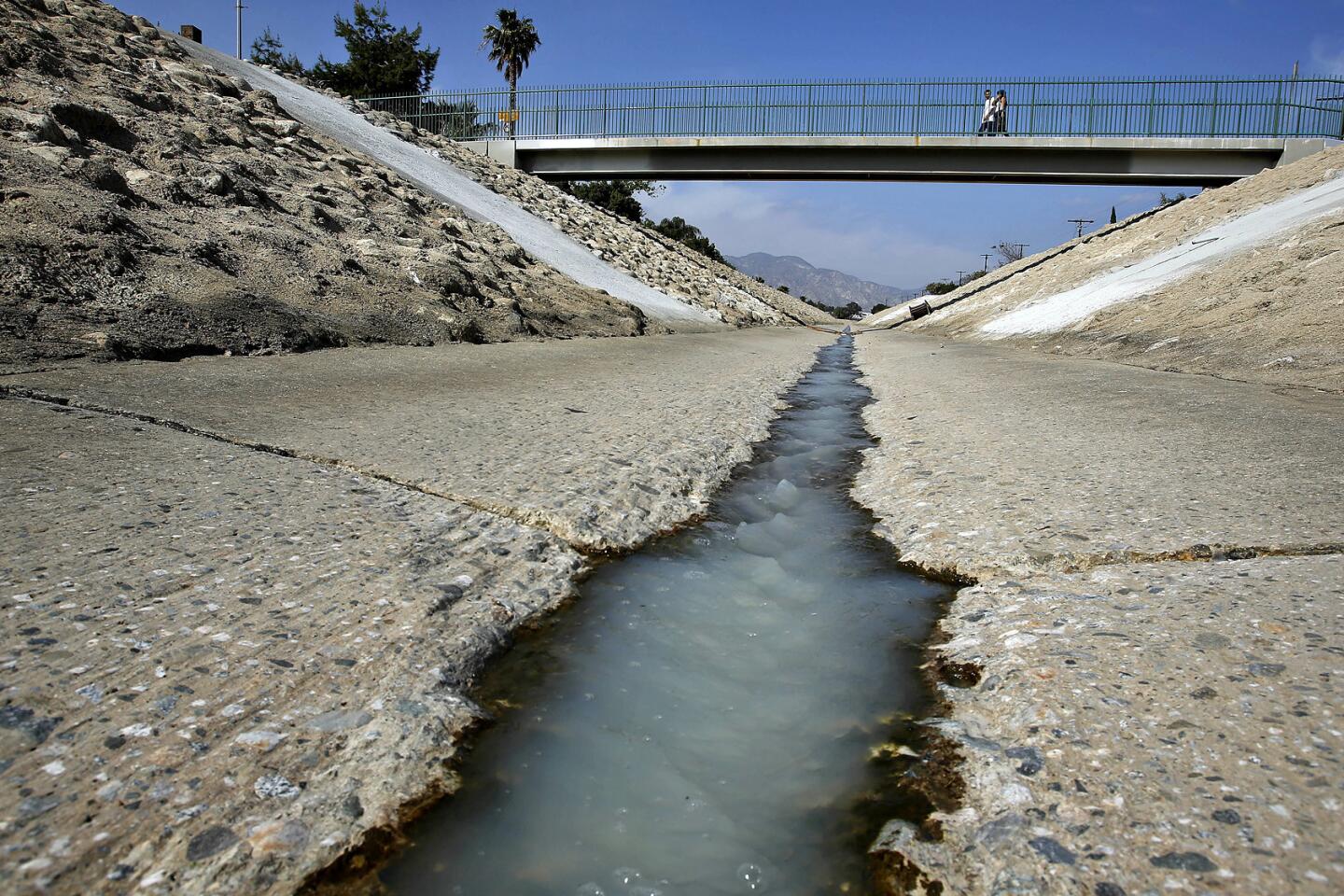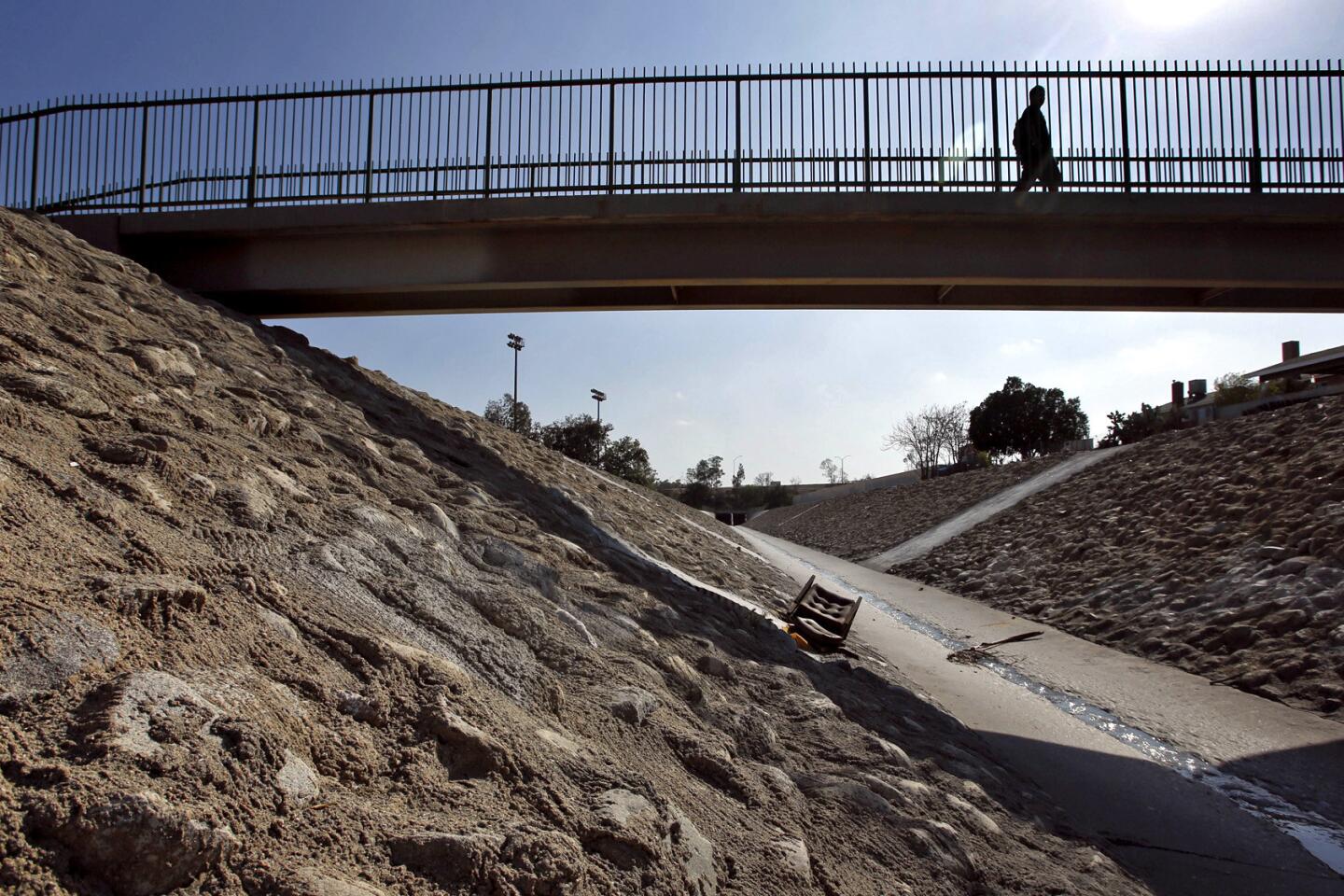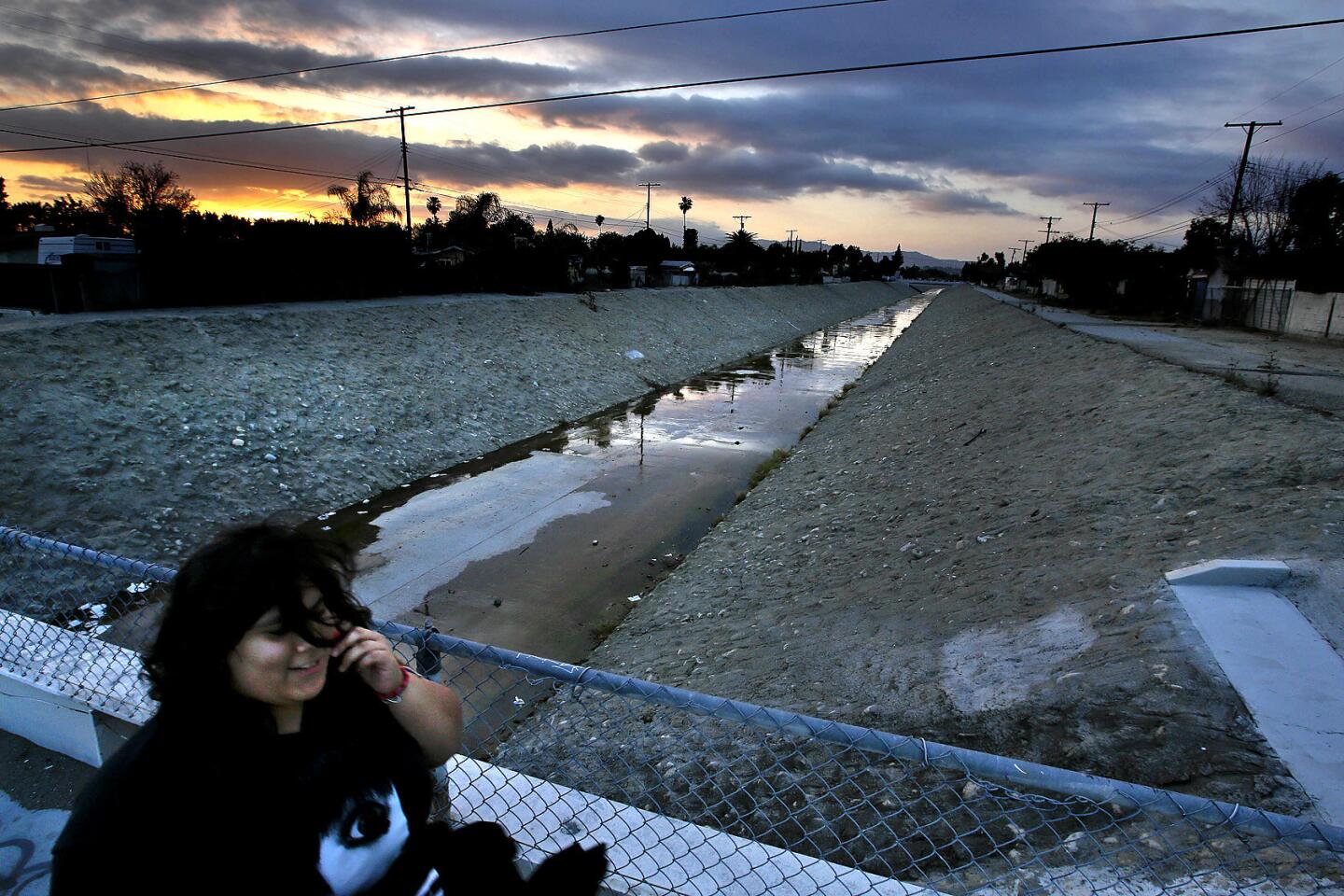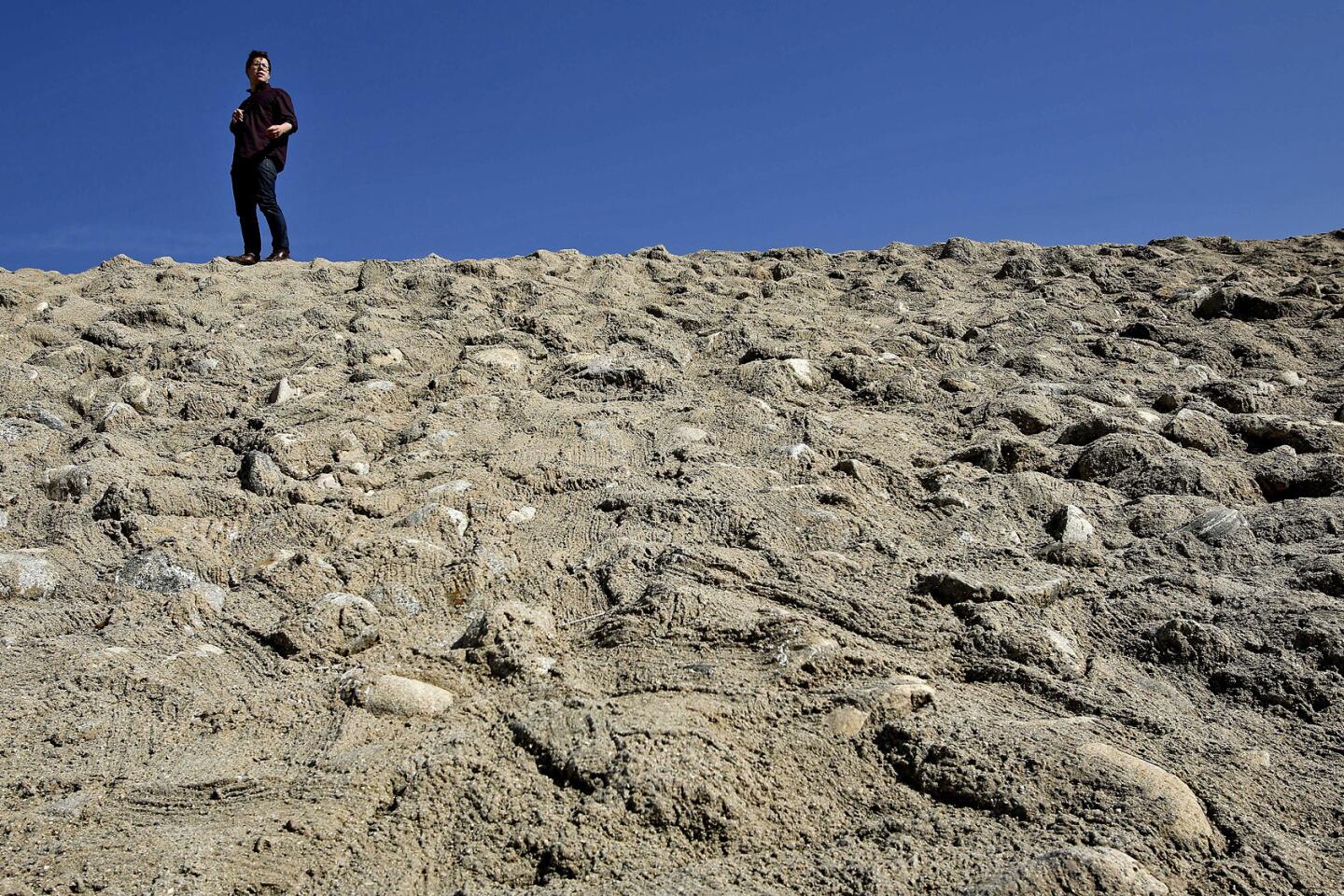Pacoima Wash is getting a makeover
- Share via
When Rosalinda Cardenas was a kid, her parents warned her often: Stay away from the Pacoima Wash.
A few blocks from her home on Laurel Canyon Boulevard, the concrete-encased flood control channel was barricaded by rusty chain-link fences, broken glass and garbage. Its steep, graffiti-marred banks were treacherous when it rained; rescuers over the years have pulled dozens of people from its fast-moving storm currents.
------------
FOR THE RECORD:
Pacoima Wash: An article in the June 9 LATExtra section about plans for transforming the Pacoima Wash reported that a vision plan for the flood-control channel had been written by a coalition led by an environmental nonprofit called Pacoima Wash. The name of the group is Pacoima Beautiful. —
------------
Problem was, you couldn’t avoid the wash, Cardenas said. It cut right through the neighborhoods of the northeast San Fernando Valley, and there were few options for getting around it.
“It was everyone’s focal point, but it was a place you’d stay away from,” said Cardenas, 54, the vice principal of Vista Del Valle Dual Language Academy, a San Fernando elementary school near the wash. “It separated communities.”
The Pacoima Wash is a tributary of the Tujunga Wash, itself a tributary of the Los Angeles River. It enters the city of Los Angeles in Sylmar, running south through the city of San Fernando and then the L.A. neighborhoods of Pacoima and Arleta.
For decades, the wash, which has few pedestrian crossings, has been a barrier in the surrounding densely populated neighborhoods ringed by freeways and industrial buildings.
Now, city officials in Los Angeles and San Fernando, as well as state and county agencies, are working to transform the Pacoima Wash from an eyesore to a pedestrian corridor, a “ribbon of green” stretching from Sylmar to Arleta. Officials are considering plans to build several miles of walking paths and bicycle lanes along the wash, as well as pedestrian bridges spanning it. There are plans for a series of parks next to the wash, which would be connected by the bike lanes.
In the coming months, construction is expected to begin on a 2-acre park in Pacoima between Telfair and El Dorado avenues.
In May, the 4.7-acre Pacoima Wash Natural Park opened in a former vacant lot between 8th Street and Foothill Boulevard in San Fernando that had once been slated to become a storage facility.
One neighbor, Gabriela Rodriguez, said the lot was long a makeshift dump, where people left refrigerators, stoves and garbage — even horses. People often broke in to hang out or skateboard in the lot and by the wash, which is mostly closed to the public, she said.
The park overlooking the Pacoima Wash now has a half-mile walking trail and native flowers and plants. For the dozens of people attending the park’s opening ceremony, there was a shared sense of pride in the space — a pride they say had long been absent.
“For too long, green parks and open space were an entitlement for certain parts of our city, certain parts of our state,” state Sen. Kevin de Leon (D-Los Angeles) told the crowd, which nodded in agreement. DeLeon wrote a 2007 law providing park grants for poor communities; at least one park next to the Pacoima Wash will receive funding through it.
“In Latino communities, there are no parks or open space,” he said. “We have asphalt, we have concrete, we have streets crowded with cars, we have alleyways crowded with sofas and abandoned furniture. Our children deserve access to open space.”
In the audience, Cardenas was misty-eyed.
“I hear a lot of parents say we’re left behind, who say these kinds of projects don’t come to our part of town,” she said. “This is going to raise the self-esteem of the community.”
Backed by a Los Angeles County Department of Public Health grant, a coalition led by the environmental nonprofit Pacoima Wash wrote the Pacoima Wash Vision Plan, which calls for 3.2 miles of bike lanes and landscaping along the wash in Pacoima and Sylmar. The nonprofit is working on plans to extend the greenway along the wash to Arleta.
San Fernando, which lies between the two L.A. neighborhoods, has its own plan to add 1.6 miles of bike lanes along the wash within its city limits.
In March, the San Fernando City Council unanimously voted to seek state funding from the California Active Transportation Program to build lighting, bridges over the wash and a bike path between Foothill Boulevard and the Metrolink railroad tracks near San Fernando Road. The portion of the project within San Fernando’s city limits is expected to cost $2.5 million, according to city documents.
If the city gets the grant, construction could begin by 2016, according to city documents.
“It’s a move in the right direction from all the hardscape out there,” said Marlene Miyoshi, San Fernando’s interim public works director.
Officials say the parks along the Pacoima Wash and the proposed bike paths will provide desperately needed open space in the densely populated neighborhoods.
The neighborhoods are close to recreational areas including the Angeles National Forest and the Hansen Dam Recreation Center in Lake View Terrace, but for many, those are unreachable, said Max Podemski, planning director for Pacoima Beautiful. The Hansen Dam, for example, is separated from Pacoima’s main residential core by a raised freeway, an airport and industrial buildings, as well as streets with fast-moving traffic and no crosswalks, he said.
“Pacoima’s location is close to lots of recreational amenities and open space,” he said. “However, because of the lack of complete streets and other barriers, and the fact that many of the people who live in the community are transit- and walking-dependent, they might as well be a hundred miles away.”
The northeast Valley suffers from high levels of obesity and diabetes, especially among children, officials said. Adding parks and paths along the wash, they hope, will improve the overall health of the community by making people more active.
“My district, historically in the state of California, is either the first- or second-worst with the rates of Type 2 diabetes among kids,” said L.A. City Councilman Felipe Fuentes, who represents the northeast Valley and has supported the remaking of the wash. “They need more active recreation space.”
Deborah Carrillo teaches fifth grade at Vista del Valle Dual Language Academy next to the new Pacoima Wash Natural Park. Every year, she said, it seems that childhood obesity and diabetes become a bigger problem, and numerous children take insulin shots during the school day.
As she walked into the new park overlooking the Pacoima Wash for the first time, she caught her breath and clutched her husband’s arm, excitedly saying she could bring her students out for walking field trips in this space where, before, they weren’t allowed.
“There are few places for them to run,” she said. “This is going to get them to come outside, and hopefully bring their families.”
More to Read
Sign up for Essential California
The most important California stories and recommendations in your inbox every morning.
You may occasionally receive promotional content from the Los Angeles Times.




















